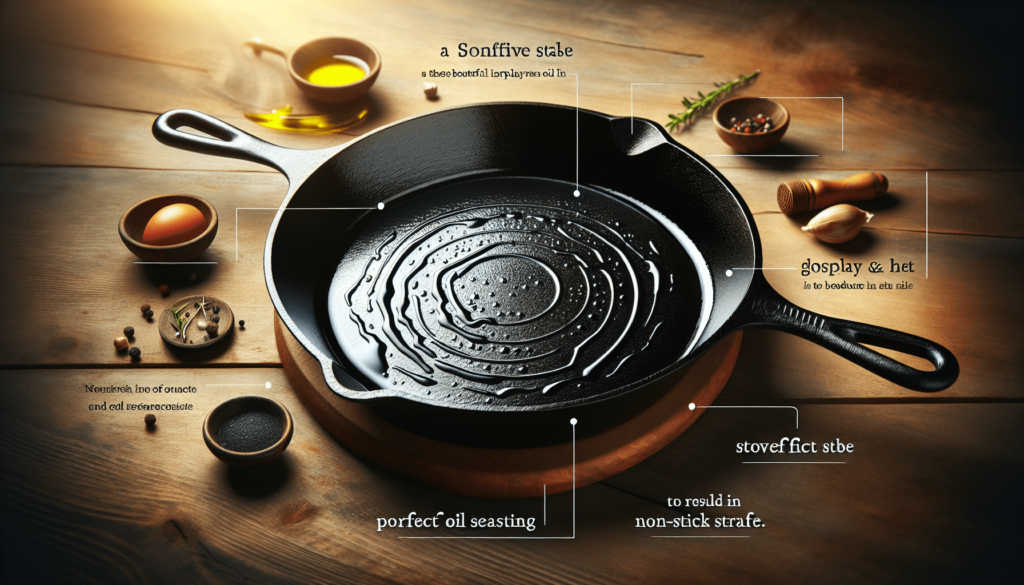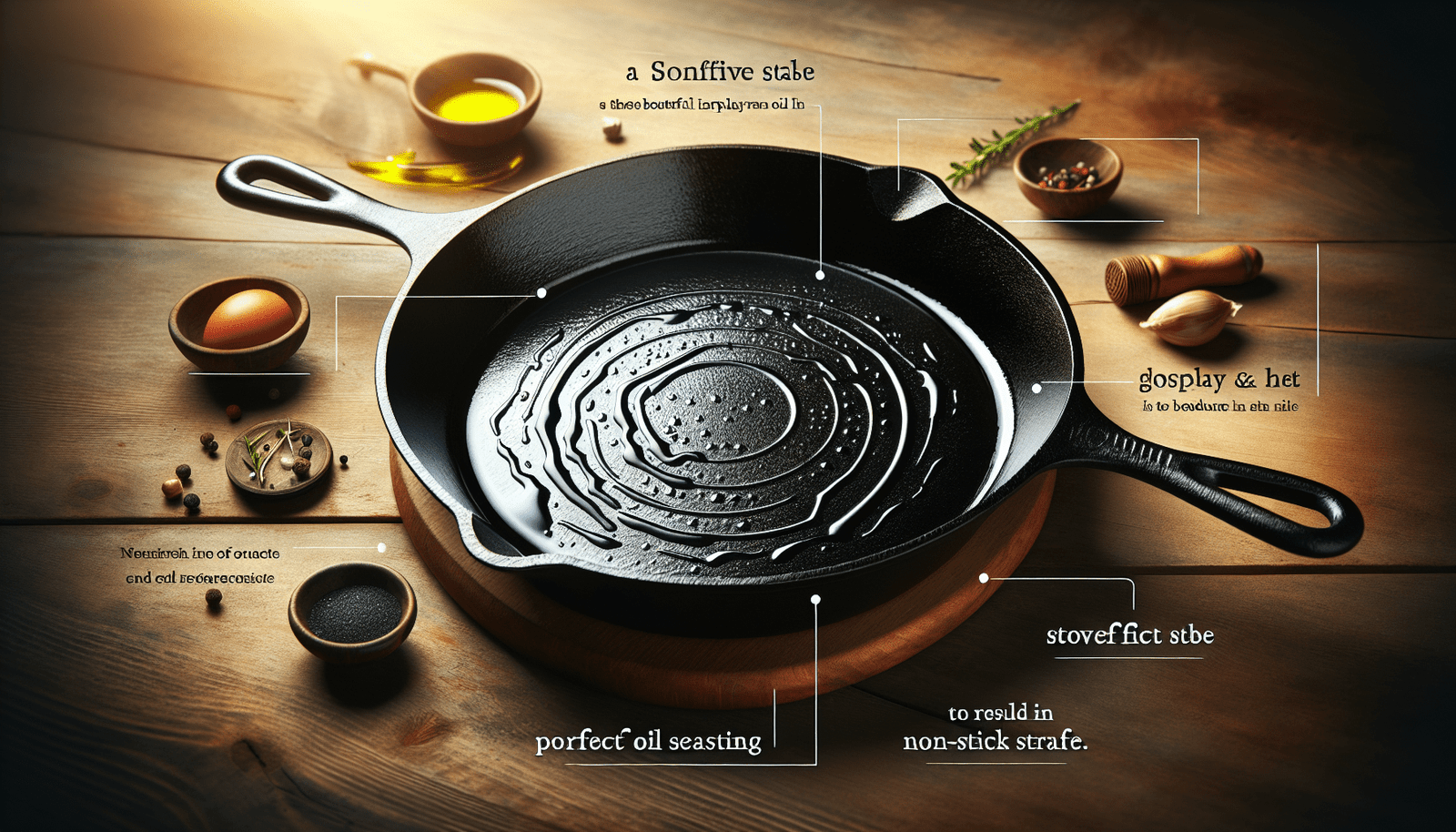How Do I Properly Season A Cast Iron Skillet?
You’ve just acquired a beautiful new cast iron skillet, but now you’re wondering how to properly season it to get it ready for cooking. Seasoning a cast iron skillet is a process that involves coating the pan with a layer of oil or fat to create a natural, non-stick surface. In this article, we’ll walk you through the steps to properly season your cast iron skillet so you can start using it to cook up delicious meals.

Why is Seasoning Important?
Before we get into the nitty-gritty of how to season your cast iron skillet, let’s talk about why seasoning is important. Seasoning not only creates a non-stick surface on your pan but also helps protect the cast iron from rust and corrosion. It also adds flavor to your dishes and helps improve the overall cooking performance of the skillet. So, taking the time to properly season your cast iron skillet is well worth the effort.
Protects from Rust and Corrosion
Cast iron is prone to rust and corrosion if not properly cared for. By seasoning your skillet, you are essentially creating a protective layer that prevents moisture from coming into direct contact with the iron, thus reducing the risk of rust and corrosion over time.
Adds Flavor to Your Dishes
As you continue to use your cast iron skillet and build up layers of seasoning, the fat molecules from the oil or fat you use during cooking become polymerized, creating a smooth, dark surface that enhances the flavors of your dishes. This is why seasoned cast iron is often prized by chefs for its ability to infuse food with a rich, delicious taste.
Improves Cooking Performance
Properly seasoned cast iron skillets have excellent heat retention and distribution properties, meaning they heat evenly and hold on to that heat well. This allows you to cook your food more evenly and regulate temperature fluctuations more effectively, resulting in better cooking results.
How to Season Your Cast Iron Skillet
Now that you understand why seasoning is important let’s dive into the step-by-step process of how to properly season your cast iron skillet. Follow these instructions to ensure your skillet is well-seasoned and ready for cooking.
-
Preheat your oven – Start by preheating your oven to 350-400°F (175-200°C). This will help the oil or fat you use to season the skillet adhere better to the surface and create a durable seasoning layer.
-
Clean the skillet – Before seasoning, make sure your skillet is clean and free of any food residues. You can use hot water and a stiff brush to remove any stuck-on food particles. Avoid using soap, as it can strip away the seasoning on the skillet.
-
Dry the skillet – After cleaning, make sure to thoroughly dry the skillet with a clean towel or by placing it over low heat on the stovetop for a few minutes. Any leftover moisture can lead to rust, so it’s essential to ensure the skillet is completely dry before seasoning.
-
Apply oil or fat – Once your skillet is dry, apply a thin layer of oil or fat to the entire surface of the skillet, including the handle and exterior. You can use vegetable oil, flaxseed oil, coconut oil, or even lard for seasoning. Make sure to coat the skillet evenly, then wipe off any excess oil with a paper towel.
| Best Oils for Seasoning |
|---|
| – Vegetable oil |
| – Flaxseed oil |
| – Coconut oil |
| – Lard |
-
Bake the skillet – Place the oiled skillet upside down on the middle rack of your preheated oven. This allows any excess oil to drip off and prevents pooling. Bake the skillet for 1-2 hours, then turn off the oven and let the skillet cool completely inside before removing it.
-
Repeat the process – To build up layers of seasoning, you’ll need to repeat the oiling and baking process several times. The more you season your skillet, the better the non-stick surface will become, so don’t be afraid to repeat these steps 3-4 times or more.
-
Store properly – Once your skillet is seasoned to your liking, make sure to store it properly to maintain the seasoning. Store the skillet in a dry place, preferably with a paper towel or cloth inside to absorb any excess moisture and keep it away from humid environments.
Maintaining Your Seasoned Cast Iron Skillet
Congratulations! You’ve successfully seasoned your cast iron skillet, and now it’s time to maintain that beautiful seasoning so you can continue to enjoy cooking with it for years to come. Here are some tips on how to care for your seasoned cast iron skillet.
Cleaning
When it comes to cleaning your seasoned cast iron skillet, less is more. Avoid using soap or harsh chemicals, as they can strip away the seasoning. Instead, use hot water and a stiff brush to scrub off any food residues. If necessary, you can also use a small amount of kosher salt as a gentle abrasive to help remove stuck-on food.
Drying
After cleaning your skillet, make sure to dry it thoroughly to prevent rust. You can place the skillet over low heat on the stovetop to evaporate any leftover moisture, then wipe it with a thin layer of oil to recondition the surface. This helps maintain the seasoning and prevents rust from forming.
Re-seasoning
Over time, the seasoning on your cast iron skillet may wear down with regular use. If you notice food sticking to the surface or rust starting to develop, it’s time to re-season your skillet. Simply follow the same steps outlined earlier to apply a fresh layer of oil or fat and bake the skillet to build up the seasoning once again.
Avoiding acidic foods
Acidic foods like tomatoes, vinegar, and citrus can break down the seasoning on your cast iron skillet. While it’s okay to cook these foods occasionally, try to avoid prolonged exposure or cooking them at high temperatures in your seasoned skillet to preserve the seasoning.
Troubleshooting Seasoning Issues
Even with proper care, seasoning issues can still arise with your cast iron skillet. Here are some common problems and how to troubleshoot them.
Food sticking
If you find that food is sticking to your cast iron skillet, it may be a sign that the seasoning layer is not properly formed or has worn down. To address this issue, try re-seasoning your skillet with multiple layers of oil or fat to build up a more robust seasoning.
Rust spots
Rust spots can develop on cast iron skillets if they are exposed to moisture or acidic foods. To remove rust, scrub the affected area with a mixture of salt and oil or use a fine-grade steel wool to gently buff away the rust. Once the rust is removed, re-season the skillet to prevent future rusting.
Uneven seasoning
If you notice that your cast iron skillet has patches of uneven seasoning, it may be due to inconsistent oil application or baking. To fix this issue, make sure to apply a thin, even layer of oil to the entire surface of the skillet and bake it upside down to allow excess oil to drip off and prevent pooling.
Conclusion
Seasoning a cast iron skillet is a simple yet essential process that helps protect your skillet, enhance flavor, and improve cooking performance. By following the steps outlined in this article and caring for your seasoned skillet properly, you can enjoy cooking with it for many years to come. So, grab that skillet, some oil, and get ready to create delicious meals with your perfectly seasoned cast iron skillet!
